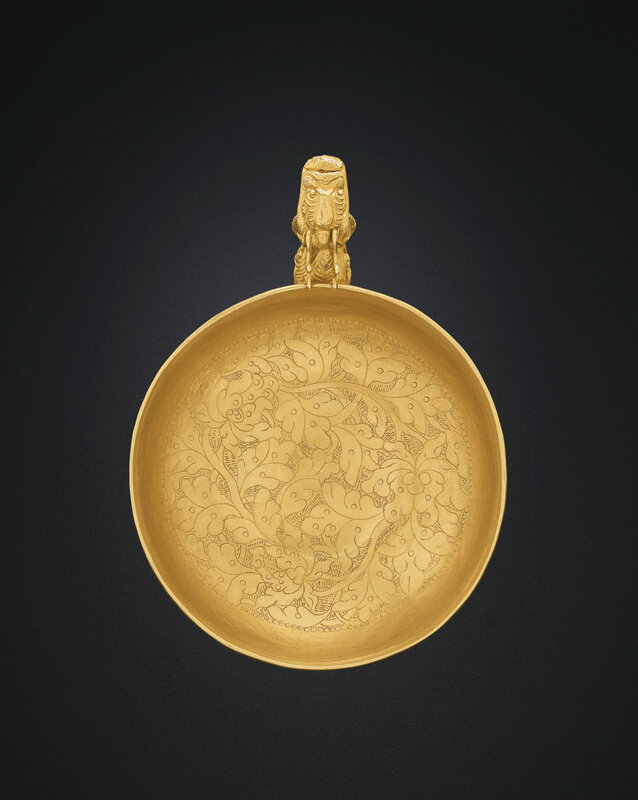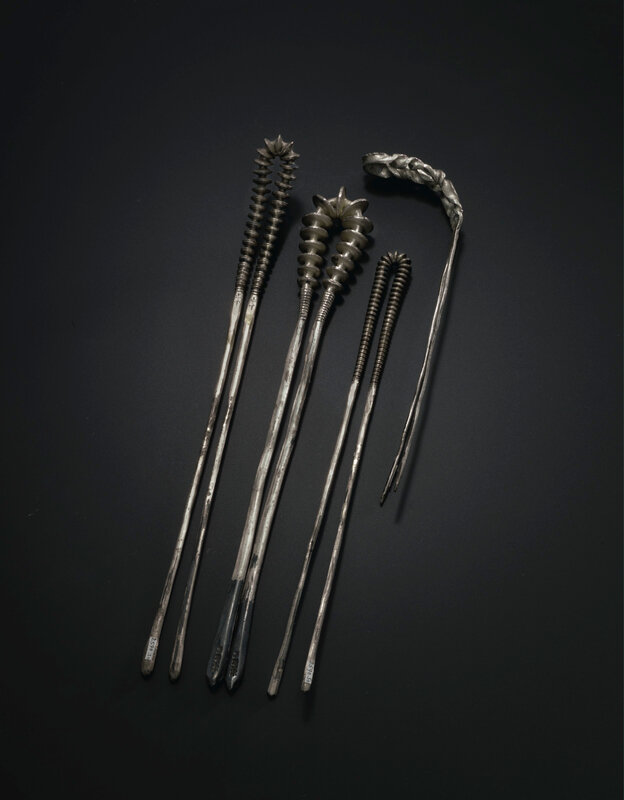Christie's. Masterpieces of Early Chinese Gold and Silver, New York, 12 September 2019
Yuan Dynasty Masterpieces of Early Chinese Gold and Silver from Dr. Johan Carl Kempe at Christie's NY 12 September 2019
Lot 571. A very rare gold 'dragon'-handled cup, Yuan dynasty (1279-1368); 4 3/8 in. (11.2 cm.) wide; weight 72.1 g. Estimate USD 600,000 - USD 800,000. Price realised USD 2,535,000. © Christie's Image Ltd 2019.
The cup has a shallow bowl with rounded sides raised on a gently flared ring foot. The handle is exquisitely executed in repoussé from two gold sheets as a dragon head suspending a loose ring from its clenched jaws. The cup is chased with a narrow band of foliate scroll below the mouth rim, and the bottom of the interior is chased with three peony blossoms borne on leafy, scrolling stems on a stippled ground within a 'bead' border.
Provenance: Madame L. Wannieck Collection, Paris, before 1937.
Dr. Johan Carl Kempe (1884-1967) Collection, Sweden, before 1953, no. CK53A.
Sotheby's London, Masterpieces of Chinese Precious Metalwork. Early Gold and Silver, 14 May 2008, lot 104.
Literature: Osvald Sirén, Kinas Konst under Tre Artusenden, vol. II, Stockholm, 1943, pl. 364.
P. W. Meister, 'Edelmetallarbeiten der Mongolen-Zeit', Ostasiatische Zeitschrift, No. 14, Berlin, 1938, pl. 7.
Bo Gyllensvärd, Chinese Gold and Silver in the Carl Kempe Collection, Stockholm, 1953, cat. no. 53A.
R. Soame Jenyns and William Watson, Chinese Art. The Minor Arts, Fribourg, 1963, pl. 14.
Zhang Linsheng, 'Zhongguo gudai di jingjin gongyi', The National Palace Museum Monthly of Chinese Art, No. 14, Berlin, 1984, p. 59, fig. 32.
Chinese Gold and Silver in the Carl Kempe Collection, The Museum of Art and Far Eastern Antiquities in Ulricehamn, Ulricehamn, 1999, pl. 50.
Chinese Ceramic Treasures, The Museum of Art and Far Eastern Antiquities in Ulricehamn, Ulricehamn, 2002, pl. 50.
Exhibited: Cologne, Kölnische Kunstverein, Asiatische Kunst, 1926, cat. no. 44.
Paris, Musée de l'Orangerie, Arts de la Chine Ancienne, 1937, cat. no. 168.
Copenhagen, Dansk Kunstindustrimuseum, Kinas Kunst i Svensk og Dansk eje, 1950, cat. no. 178.
Washington, D.C., Smithsonian Institution, Chinese Gold and Silver in the Carl Kempe Collection, 1954-55, cat. no. 53A.
Cleveland, Cleveland Museum of Art, Chinese Art Under the Mongols: The Yüan Dynasty (1279-1368), 1968, cat. nos. 34a, 34b.
New York, Asia House Gallery, Chinese Gold, Silver and Porcelain. The Kempe Collection, 1971, cat. no. 22, an exhibition touring the United States and shown also at nine other museums.
Note: A gold cup, dated Song dynasty, with deep, rounded sides raised on a low, spreading pedestal foot and similarly chased below the thickened rim with a foliate scroll band, in The Metropolitan Museum of Art, New York, is illustrated by Dr. Paul Singer, Early Chinese Gold & Silver, China Institute in America, New York, 1971-1972, p. 69, no. 99. The cup retains one of a pair of repoussé, lion-form handles applied to the side. A gold cup (8.5 cm. diam.) with a band of lingzhi chased on the exterior below the rolled rim, and with a leafy peony stem chased in the bottom of the interior is illustrated by Jianshe Yu, ed., Essence of Chifeng Historical Relics Series, 2006, p. 177, pl. CJ120, where it is dated Jin dynasty. Unlike the present gold cup, it does not have a handle and rests on a flat base. Also illustrated, p. 182, pl. CJ126, is a silver cup (8 cm. diam.) raised on a foot, with a lingzhi-form handle on one side and a band of foliate scroll chased in stippling below the rim on the exterior, which is dated Yuan dynasty. A gold bowl (8.4 cm. diam.) dated Song-Yuan illustrated by Peter Y. K. Lam, ed., Celestial Creations: Art of the Chinese Goldsmith, The Cheng Xun Tang Collection, Art Museum, Institute of Chinese Studies, The Chinese University of Hong Kong, 2007, pp. 234, no. D35, has a band of classic scroll punched below the rolled rim. A related silver cup, also with a repoussé handle, in the collection of Pierre Uldry, is illustrated in Chinesisches Gold und Silber, Zurich, 1994, p. 224, no. 261, where it is dated 13th-14th century, Xixia or Yuan dynasty. Unlike the medallion of flowering peony stems engraved in the center of the gold cup, the silver cup is engraved in the center with the lanca character, om, implying a Buddhist context for the cup.
The loose gold ring suspended from the dragon-head handle may relate this cup to nomadic culture, as the ring would have allowed the cup to be hung from a belt. In general, gold utensils were held in high esteem at the Mongol court, as can be seen by several gold vessels from Inner Mongolia illustrated by James C. Y. Watt et al., The World of Khubilai Khan: Chinese Art in the Yuan Dynasty, The Metropolitan Museum of Art, New York, 2010, pp. 6-7, fig, 3, a gold stem cup, fig. 4, a lobed cup with ring handle below a shaped thumbpiece, and fig. 5, a lobed bowl and a lobed cup stand, the latter two dated Xixia dynasty (1018-1127). All of these have a narrow band of foliate scroll below the rim.
Lot 572. A rare and finely decorated gold 'peony' dish, Yuan dynasty (1279-1368); 6 1/8 in. (15.6 cm.) diam.; weight 121.1 g. Estimate USD 200,000 - USD 300,000. Price realised USD 591,000. © Christie's Image Ltd 2019.
The dish is finely chased in the center with a medallion enclosing seven, small ring-punches that form a circle within a border of overlapping hatching, all encircled by a wide band of densely arranged peony stems bearing five large blossoms on a stippled ground within a border of stamen. The flat, everted rim is chased with a band of foliate scroll below the rolled edge.
Provenance: Madame L. Wannieck Collection, Paris, before 1937.
Dr. Johan Carl Kempe (1884-1967) Collection, Sweden, before 1953, no. CK53B.
Sotheby's London, Masterpieces of Chinese Precious Metalwork. Early Gold and Silver, 14 May 2008, lot 102.
Literature: P.W. Meister, 'Edelmetallarbeiten der Mongolen-Zeit', Ostasiatische Zeitschrift, No.14, Berlin, 1938, pl. 7.
Bo Gyllensvärd, Chinese Gold and Silver in the Carl Kempe Collection, Stockholm, 1953, cat. no. 53B.
Zhang Linsheng, 'Zhongguo gudai di jingjin gongyi', The National Palace Museum Monthly of Chinese Art, No. 14, Beijing, 1984, p. 59, fig. 32.
Chinese Gold and Silver in the Carl Kempe Collection, The Museum of Art and Far Eastern Antiquities in Ulricehamn, Ulricehamn, 1999, pl. 51.
Chinese Ceramic Treasures, A Selection from Ulricehamn East Asian Museum, including The Carl Kempe Collection, The Museum of Art and Far Eastern Antiquities in Ulricehamn, Ulricehamn, 2002, pl. 51.
Exhibited: Cologne, Kölnische Kunstverein, Asiatische Kunst, 1926, cat. no. 44.
Paris, Musée de l'Orangerie, Arts de la Chine Ancienne, 1937, cat. no. 168.
Copenhagen, Dansk Kunstindustrimuseum, Kinas Kunst i Svensk og Dansk eje, 1950, cat. no. 178.
Washington, D.C., Smithsonian Institution, Chinese Gold and Silver in the Carl Kempe Collection, 1954-55, cat. no. 53B.
Cleveland, Cleveland Museum of Art, Chinese Art Under the Mongols: The Yüan Dynasty (1279-1368), 1968, cat. nos. 34a, 34b.
New York, Asia House Gallery, Chinese Gold, Silver and Porcelain. The Kempe Collection, 1971, cat. no. 22, an exhibition touring the United States and shown also at nine other museums.
Note: Dishes with a flat rim encircled by a low ridge on the outer edge appear in silver beginning in the Tang dynasty, which is when silver began to be used on a more regular basis for fine vessels. During the Song dynasty dishes of this type continued to be made in silver, and also more rarely in gold, most likely for use at the imperial court. A gold dish of similar shape and slightly smaller size (15.4 cm. diam.), chased in the center with lotus decoration and with 'cash' diaper pattern on the rim, formerly in the collection of Christian Holmes and the Hon. Senator Hugh Scott, Washington, D.C., and now in the collection of Pierre Uldry, is illustrated in Chinesisches Gold und Silber, Zurich, 1994, p. 230, no. 272, where it is dated Song, as is a smaller (14.2 cm. diam.) silver dish decorated with a large peony stem, illustrated p. 230, no. 273. Also illustrated, p. 166, pl. 154, is a Tang silver dish of similar shape and comparable size (15.8 cm. diam.) which has the same central decoration as seen on the present gold dish. This central decoration of small circles in a ring within a circular medallion may represent a lotus pod, a motif seen in the center of lacquer 'lotus' dishes of Yuan date, such as the examples illustrated by Sherman E. Lee and Wai-Kam Ho, Chinese Art Under the Mongols: The Yüan Dynasty (1279-1368), The Cleveland Art Museum of Art, 1968, nos. 288-91. The inclusion of the central decoration on both the gold and silver dishes may imply that these dishes were made as cup stands.
These valuable gold and silver dishes are thought to be the inspiration for dishes of the same shape made at the Ding kilns during the 11th-12th centuries. Ding dishes of this type, also decorated with floral motifs in the interior, include an example in the Palace Museum, Beijing, illustrated in The Complete Collection of Treasures of the Palace Museum - 32 - Porcelain of the Song Dynasty (I), Hong Kong, 1996, p. 76, no. 67, and two examples illustrated by Tsai Meifen, Decorated Porcelains of Dingzhou: White Ding Wares from the Collection of the National Palace Museum, Taipei, 2014, p. 69, no. II-24.
Lot 588. A group of four silver hairpins, Yuan dynasty (1279-1368); 5 5/8, 7 ¼, 8 1/8 and 8 ½ in. (14.3, 18.4, 20.7 and 21.6 cm.) long; total weight 125.2 g. Estimate USD 5,000 - USD 7,000. Unsold. © Christie's Image Ltd 2019.
The group is comprised of three similarly shaped double-pronged hairpins encircled by graduated disks, and a hairpin with a twisted flower scroll terminal.
Provenance: Dr. Johan Carl Kempe (1884-1967) Collection, Sweden.
Sotheby's London, Masterpieces of Chinese Precious Metalwork. Early Gold and Silver, 14 May 2008, lot 111.
Literature: Chinese Gold and Silver in the Carl Kempe Collection, The Museum of Art and Far Eastern Antiquities in Ulricehamn, Ulricehamn, 1999, pls. 149, 150, 151 and 157.

/https%3A%2F%2Fprofilepics.canalblog.com%2Fprofilepics%2F1%2F0%2F100183.jpg)
/https%3A%2F%2Fstorage.canalblog.com%2F03%2F02%2F119589%2F96711876_o.jpg)
/https%3A%2F%2Fstorage.canalblog.com%2F11%2F31%2F119589%2F94773502_o.jpg)
/https%3A%2F%2Fstorage.canalblog.com%2F20%2F83%2F119589%2F94772815_o.jpg)
/https%3A%2F%2Fstorage.canalblog.com%2F26%2F72%2F119589%2F75604929_o.jpg)
/https%3A%2F%2Fstorage.canalblog.com%2F59%2F60%2F119589%2F26458628_o.jpg)








/image%2F1371349%2F20240415%2Fob_308536_436292768-1650079115762101-83406494688.jpg)
/image%2F1371349%2F20240408%2Fob_b3fc19_435359290-1647758335994179-79867038222.jpg)
/image%2F1371349%2F20240406%2Fob_9e792c_435377691-1644764672960212-80619555723.jpg)
/image%2F1371349%2F20240406%2Fob_d1f50a_436272281-1646702666099746-69647680342.jpg)